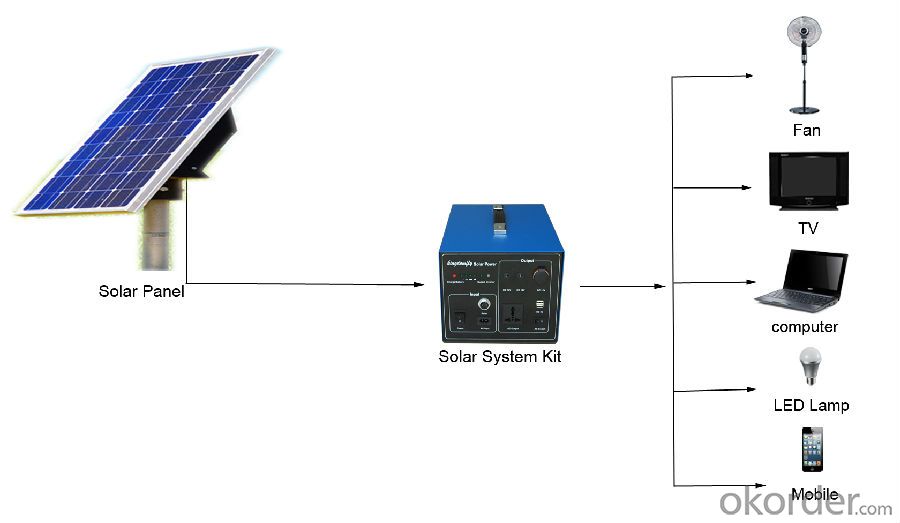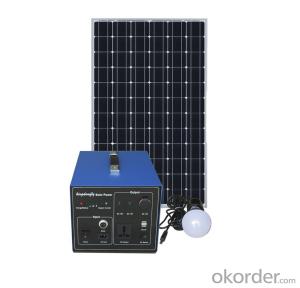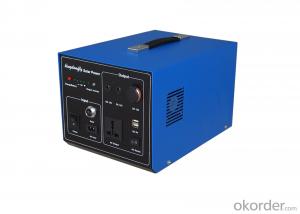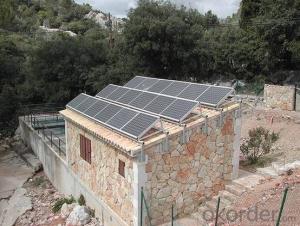Portable Solar Lighting System Hot Selling SPS_80W
- Loading Port:
- China main port
- Payment Terms:
- TT OR LC
- Min Order Qty:
- 3 pc
- Supply Capability:
- 10000 pc/month
OKorder Service Pledge
OKorder Financial Service
You Might Also Like
Main Information
SPS_80W This product is high performance,family used portable solar power system,which can receive energy and store it in battery outside connected to SPK by solar energy on sunny day,and supplies electric power for varies appliances such as electric fan,lighting lamps, television, portable computer etc.It can supply power for both DC and AC electric application .It’s very helpful and useful for home electric supply.

Features
◆ Both Solar charge input and AC charge input.
◆ Both DC and AC output
◆ Solar Feedback Circuit Protection
◆ Output Short-circuit Protection
◆ Solar「+」「-」anti-access protection
◆ Output「+」「-」anti-access protection
◆ Over Charged Protection
◆ Over Discharged Protection
◆ Over Load Protection
◆ Over-Temperature Protection
Technical parameters
Specification | Value/Material | |
Item No. KDF | SPS_80W | |
Solar Recommended | Specification | Poly silicon |
Working Voltage/Power | 18V80WP | |
Battery | Rated Voltage/Capacity | 12V40AH |
Cycle Number | 80% Deep Cycle Number:500 70% Cycle Number:800 | |
Working Temperature | Short Period(one Month):-20~50℃ Long Period(Six Months):-10~45℃ | |
Charging Controller | Operating Voltage | 12V |
Input Voltage | 17.3V~21V | |
Input current | MAX:10A | |
Power Consumption | MAX: 5mA | |
Low Voltage Disconnect(LVD) | 10.8V | |
Low Voltage Reconnect(LVR) | 12.3V | |
High Voltage Discharge( HVC) | 14.6V | |
High Voltage Recharge(HVR) | 13.8V | |
Temperature Protection | 60℃ | |
DC Output | DC output & Application | USB 5V1A*2 |
DC output & Application | DC 12V1*4A | |
AC Output | Output Wave | Modified Wave |
Input Voltage | 11V~15V | |
Output Voltage | 110V±10% | |
Output Frequency | 60Hz±2Hz/50Hz±2Hz | |
Rated Output Power | 300W/500W | |
Maximum VA | 600VA/1000VA | |
Maximum Efficiency | 88% | |
Temperature | 0-40℃ | |
Over Temperature | 60℃~70℃ | |
Low Voltage Alarm | 11V | |
Low Voltage Shut off | 10.5V | |
High Voltage Shut off | 16V | |
Package | Set size | 328*252*267mm |
Set N·W | 11.6kg | |
Set N·W | 12.8kg | |
- Q:What is the impact of hail on solar panels?
- Hail can have a detrimental impact on solar panels, as the forceful impact of hailstones can cause physical damage to the panels. This damage can result in cracks or fractures in the glass or photovoltaic cells, reducing the efficiency and effectiveness of the panels. Furthermore, hail can also impair the electrical connections within the solar panel system, leading to malfunction or complete failure. Therefore, it is important to consider protective measures, such as installing hail guards or utilizing insurance policies, to mitigate the potential damage caused by hail on solar panels.
- Q:Can solar energy systems be used for powering electric vehicle solar charging roads?
- Yes, solar energy systems can be used to power electric vehicle solar charging roads. Solar panels can be installed alongside or on top of the roads, converting sunlight into electricity. This electricity can then be used to power electric vehicle charging stations located along the roads, allowing vehicles to charge their batteries while driving. This innovative technology can help reduce dependence on fossil fuels and promote sustainable transportation options.
- Q:What are the disadvantages of using solar energy?
- One of the main disadvantages of using solar energy is its intermittent nature. Solar power can only be generated during daylight hours and is greatly affected by weather conditions, such as cloudy days or long periods of darkness. This means that solar energy may not be available consistently, which can be a downside for those who rely solely on solar power. Additionally, the initial installation cost of solar panels and equipment can be quite expensive, although the long-term savings on energy bills can offset this. Lastly, solar energy production requires a large amount of space, making it challenging to implement in densely populated areas or areas with limited available land.
- Q:Can a solar energy system be used in areas with limited sunlight?
- Yes, a solar energy system can still be used in areas with limited sunlight. While it is true that solar panels produce the most electricity when exposed to direct sunlight, they can still generate power even in areas with limited sunlight. Solar panels can still produce electricity on cloudy days or during periods of low sunlight, albeit at a reduced efficiency. Additionally, advancements in solar panel technology have made it possible for panels to capture and convert even diffuse sunlight, which means they can still function in areas with limited direct sunlight. Moreover, solar energy systems can be designed to include energy storage solutions such as batteries, allowing for the storage of excess energy generated during periods of peak sunlight for use during periods of limited sunlight. This ensures that solar energy can still be utilized in areas with limited sunlight, making it a viable and sustainable energy solution for various regions around the world.
- Q:Can solar energy systems be used for powering electric vehicle showrooms?
- Certainly, solar energy systems have the capability to power electric vehicle showrooms. Solar energy, which is both clean and renewable, can effectively supply electricity to a wide array of applications, such as commercial buildings like showrooms. By installing solar panels on the showroom's roof or surrounding areas, the sun's energy can be converted into electricity. This generated electricity can then be utilized to operate various functions within the showroom, including lighting, air conditioning, charging stations, and other electrical equipment. This not only decreases reliance on grid electricity, but it also aids in lowering carbon emissions and promoting sustainability. Moreover, solar energy systems can offer a cost-effective solution in the long term, as they contribute to reducing or eliminating electricity bills while providing a reliable and consistent power source.
- Q:Can solar energy systems be used in powering wineries or breweries?
- Certainly, wineries and breweries can utilize solar energy systems to effectively power their operations. Indeed, solar power has been widely embraced by many wineries and breweries worldwide as a sustainable and cost-efficient energy solution. These facilities can install solar energy systems on their rooftops or surrounding areas to capture sunlight and convert it into usable electricity. The electricity generated from solar panels can be employed to power various aspects of winemaking or brewing, including lighting, heating, cooling, and machinery. It can also be used for irrigation pumps and ventilation systems, which are critical for maintaining optimal fermentation conditions. By employing solar power, wineries and breweries not only reduce their carbon footprint and dependence on fossil fuels, but also enjoy several financial advantages. Solar energy systems can significantly decrease utility bills, as these establishments typically require a substantial amount of electricity for their operations. Furthermore, certain regions offer incentives and tax credits to businesses that adopt renewable energy sources like solar power. In addition, solar energy systems provide wineries and breweries with energy independence and reliability. These systems can generate electricity even during power outages or peak demand periods when electricity prices are higher. This ensures uninterrupted production and reduces the vulnerability of these facilities to energy shortages or price fluctuations. Overall, the effectiveness of solar energy systems in powering wineries and breweries has been well-documented, offering environmental, financial, and operational benefits. By harnessing the abundant power of the sun, these industries can contribute to a more sustainable future while enjoying the numerous advantages of solar energy.
- Q:Can solar panels be installed on floating platforms or buoys in bodies of water?
- Yes, solar panels can be installed on floating platforms or buoys in bodies of water. This concept, known as floating solar or floating photovoltaic (FPV), is gaining popularity as it offers several advantages such as utilizing underutilized water surfaces, reducing evaporation, and increasing energy generation due to the cooling effect of water. It also minimizes land use conflicts and can be deployed in various bodies of water including lakes, reservoirs, and even oceans.
- Q:Can solar energy systems be used in areas with limited access to solar energy research facilities?
- Yes, solar energy systems can be used in areas with limited access to solar energy research facilities. Solar energy systems primarily rely on the availability of sunlight, which is a widely accessible resource. While access to research facilities may provide additional knowledge and expertise, the basic principles of solar energy can be understood and implemented even without direct access to such facilities. Additionally, advancements in technology and the availability of online resources have made it easier for individuals and communities to learn about and install solar energy systems, regardless of their proximity to research facilities.
- Q:Are there any risks of electrical surges or voltage fluctuations with solar energy systems?
- Solar energy systems come with potential risks of electrical surges or voltage fluctuations. Although the solar panels themselves do not cause these issues, integrating the systems with the existing electrical grid can present challenges. One risk arises from sudden changes in sunlight intensity, which can lead to voltage fluctuations. For instance, when a cloud passes over a solar panel, the abrupt decrease in sunlight can result in a drop in voltage output. Conversely, when the cloud passes, the sudden increase in sunlight can cause a surge in voltage output. These fluctuations have the potential to impact the stability of the electrical grid. Another risk is associated with the inverters utilized in solar energy systems. Inverters convert the direct current (DC) produced by solar panels into alternating current (AC), which is compatible with the electrical grid. Inverter failure or malfunction can cause voltage fluctuations or surges, potentially damaging electrical equipment or disrupting the electrical supply. To address these risks, solar energy systems typically include protective devices such as surge protectors and voltage stabilizers. Surge protectors divert excess energy away from the system to prevent voltage spikes, while voltage stabilizers regulate voltage levels to ensure a steady and safe supply of electricity. Furthermore, proper installation and regular maintenance of solar energy systems are crucial in minimizing the risks of electrical surges or voltage fluctuations. Qualified professionals should handle the installation process, ensuring correct connections and grounding of all components. Routine inspections and maintenance checks can help identify and resolve any issues before they escalate into serious problems. In conclusion, while solar energy systems offer many benefits, it is important to acknowledge and address the potential risks associated with electrical surges or voltage fluctuations. By implementing suitable protective devices, following proper installation and maintenance procedures, and collaborating with qualified professionals, these risks can be effectively managed, guaranteeing the safe and reliable operation of solar energy systems.
- Q:Can solar energy systems be used in areas with limited access to cultural resources?
- Yes, solar energy systems can be used in areas with limited access to cultural resources. Solar energy systems are not dependent on cultural resources such as historical structures or artifacts. They can be implemented in any location as long as there is access to sunlight. Therefore, areas with limited cultural resources can still benefit from solar energy as an alternative and sustainable source of power.
1. Manufacturer Overview |
|
|---|---|
| Location | |
| Year Established | |
| Annual Output Value | |
| Main Markets | |
| Company Certifications | |
2. Manufacturer Certificates |
|
|---|---|
| a) Certification Name | |
| Range | |
| Reference | |
| Validity Period | |
3. Manufacturer Capability |
|
|---|---|
| a)Trade Capacity | |
| Nearest Port | |
| Export Percentage | |
| No.of Employees in Trade Department | |
| Language Spoken: | |
| b)Factory Information | |
| Factory Size: | |
| No. of Production Lines | |
| Contract Manufacturing | |
| Product Price Range | |
Send your message to us
Portable Solar Lighting System Hot Selling SPS_80W
- Loading Port:
- China main port
- Payment Terms:
- TT OR LC
- Min Order Qty:
- 3 pc
- Supply Capability:
- 10000 pc/month
OKorder Service Pledge
OKorder Financial Service
Similar products
New products
Hot products
Hot Searches
Related keywords






























